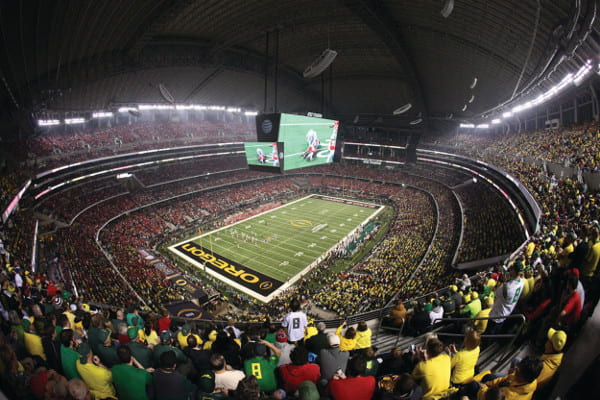By JOHN WYATT – SPORTS SECTION EDITOR
The 2014-2015 season in college football saw the first-ever College Football Playoffs. The new postseason tournament has four teams play in two semifinal games, with the two winners advancing to the championship game. In an effort to keep the bowl games relevant within the new system, the current playoff scheme has six bowl games that will rotate on a three-year cycle to act as hosts for the semifinal bowl games.
This year saw the Alabama University Crimson Tide and the Ohio State University Buckeyes face off in the Sugar Bowl, and the Florida State University Seminoles and the Oregon University Ducks play in the Rose Bowl. Both Oregon and Ohio State (the underdog and controversial playoff pick) came out on top to advance to the final National Championship game.
The decision to place Ohio State as the fourth seed in the playoff was a controversial one. Several analysts and journalists argued that teams like the Texas Christian University Super Frogs or the Baylor University Bears should and would get the fourth spot, and depending on what day you asked the Buckeyes, they might have also. The Buckeyes had to overcome not one, but two injured Heisman Trophy contenders and an ugly loss to the Virginia Tech HokieBirds to make it to the playoffs.
But on Jan. 12, Ohio State finally had a chance to silence the doubters. The Buckeyes defeated the No. 2 Ducks in a decisive victory. As the underdogs they defeated an incredibly loaded Oregon team 42-20 to take home the National Championship in the first-ever playoff series.
The shocking part wasn’t so much that the Buckeyes won, but how badly they beat the Ducks.
Prior to kickoff, the Ducks came in with a ton of momentum following their Rose Bowl victory, where they completely dismantled a very talented Florida State team led by potential first pick in the NFL draft Jameis Winston. The Ducks scored 59 points to the Seminoles’ 20, forcing turnover after turnover in a completely dominating performance. Ohio State’s margin of victory was much smaller against the top-seeded Alabama (42-35).
The Ducks seemingly had all of the pieces for a championship run this year: a Heisman quarterback, highly touted offensive and defensive lines, and a lightning quick offense that kept sluggish opponents guessing. But unfortunately for Ducks fans, that all came crashing down.
Out of the gate, the Ducks briefly looked like the well-oiled offensive machine that they were all season, scoring a quick touchdown by the 12-minute mark taking a 7-0 lead. But third-string quarterback Cardale Jones led the Buckeyes to a commanding 21-7 lead midway through the second quarter, completing several lengthy passes. Though he had a bit of a slump in the second half, Jones and running back Ezekial Elliott orchestrated an incredible 75-yard touchdown drive that pushed the Buckeyes’ lead to eight.
Ohio State’s defense also played a huge role in the victory. The Buckeyes forced the Ducks into three punts in the first quarter, marking the first time the Ducks had to punt three or more times in the first 15 minutes of a game since 2009—a cringe-worthy stat for their fans.
Some of the Ducks’ woes can be chalked up to personnel loss, as they lost some potential receiving targets prior to this game. Wide receiver Darren Carrington was ruled ineligible for the championship game after failing a drug test, and therefore joined injured redshirt freshmen Devon Allen and tight end Pharoah Brown on the sidelines.
The most decisive moment of the game probably came towards the end of the first quarter. Ohio State hit Oregon with back-to-back scoring drives. Following a sloppy Oregon possession (something we rarely saw from this team), the Buckeyes drove the ball across midfield hoping to take a 14-point lead early into the second quarter. Fortunately for Oregon, an otherwise stellar Jones dropped the ball in a handoff, letting defensive tackle Alex Balducci to scoop up the loose ball. The Ducks drove the ball deep into Ohio State red zone. Then, Mark Helfrich took one of the biggest gambles of his career. Instead of attempt the short field goal, the Ducks opted for a fourth-down. The Buckeyes defense managed to stop the Ducks just shy of the end zone, essentially marking the downfall of the Ducks for the rest of the game.
From there, the rest was history. The Buckeyes proved that they not only belonged in the playoffs, but became the champions.
It was a heartbreaking loss for Oregon fans. This loss marked the second time in the last five years that the Ducks fell short in the National Championship game. With several key players leaving for the NFL, most notably star quarterback Marcus Mariota, one wonders just how long it will be before Oregon gets another crack at the championship.
Meanwhile, Jones announced he would be returning to school for another year, along with two-time Big Ten player of the year Braxton Miller, who is still recovering from shoulder surgery, and highly touted quarterback J.T. Barrett. Needless to say, the Buckeyes will have talented players to make another run next year.
As for the new playoff system, most people seem to enjoy it. ESPN announced that it was the most watched event in the station’s history, with a 21 percent increase over last year’s BCS National Championship game between Florida State and the Auburn University Tigers. If we can take away anything from its inaugural year, it’s that good teams can come from bad leagues. It has now been two years since an SEC team won the national championship, with the most recent two champions coming from the ACC and the Big Ten—two of the most criticized leagues out of the Power 5 conferences. Instead of rewarding a team for the opponents around them, the new playoff system rewards them based on the talent that the coaching staff has recruited.

